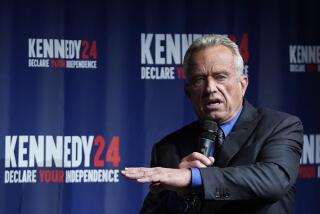Prop. 53 Would Mandate Funding for Infrastructure
Is it time for voters to again step in and force state lawmakers to act, in this case making them spend more to repair highways, reservoirs and other vital but unglamorous public structures?
Or will that only make it harder for the Legislature to manage California’s rickety finances?
Those questions go to the heart of Proposition 53, one of two measures accompanying the governor’s recall election on the Oct. 7 ballot.
Proposition 53 asks voters to dedicate as much as 3% of the state’s main pool of tax revenue to pay for the mainstays of government: courthouses, freeways, crime labs, canals, parks, prisons, office buildings and mental hospitals.
Proposition 53 would not generate any new revenue. Instead, like several other initiatives passed by voters in recent years that have siphoned off money for education and after-school programs, the initiative would earmark a portion of existing state money.
Critics say the initiative would worsen an already bad budget situation in Sacramento by stealing flexibility from lawmakers as they struggle each year to craft the state’s spending plan.
“With the budget tied in knots, it just adds more knots,” said Lenny Goldberg, executive director of the California Tax Reform Assn.
Proposition 53 got on the ballot as a result of an existing budget knot. Last summer, the Democratic majority in the Legislature agreed to put the measure before voters at the request of Assemblyman Keith Richman (R-Northridge), one of four Republicans to vote for the budget and thus to end a 62-day stalemate.
Richman said he wished the ballot measure were not necessary. Ideally, he said, the Legislature would make regular investments in university classrooms, water pipelines, highways and public hospitals.
“In the 1960s, we spent 15% to 20% of our budget on infrastructure,” he said. “Now, on a pay-as-you-go fashion, we spend 0.2% of our general fund on infrastructure investment. Including bonds, it’s about 2%.
“When people wonder why our roads are crowded, why they’re crumbling, why our water supplies are inadequate -- the Legislature has clearly not had the financial discipline to invest in infrastructure.”
Richman and his co-author, Assemblyman Joe Canciamilla (D-Pittsburg), crafted Proposition 53 with the intent of ensuring that, when California’s revenues dip, the ballot measure would not apply.
But if the ballot measure were to pass and the economy grew, the first transfers into an “infrastructure fund” would begin in 2006-07, with 1% of the general fund. That’s an estimated $850 million.
If state revenues continued to grow, infrastructure spending would increase at a rate of .3% a year until it reached a maximum of 3% of the general fund in 2013-14.
Other provisions in the initiative could reduce payments to the infrastructure fund when school attendance grows faster than the statewide population or when California’s bond debt payments increase significantly.
Assuming steady growth in state revenues, several billion dollars a year could be set aside under Proposition 53.
But the provisions of the initiative would not always protect the general fund in years when state expenses outstrip revenues, according to the California Budget Project, a nonprofit group that researches how state policies affect low-income residents.
The group analyzed what would have happened in the 1990s, had Proposition 53 been in place. It concluded that $285 million would have been transferred from the general fund to the infrastructure fund, even in 1991-92, when the state faced a shortfall estimated at $14.3 billion.
“Even when you try to build in a trigger, they don’t always work like they should,” said Jean Ross, executive director of the California Budget Project.
Goldberg of the tax reform association said Proposition 53 would, for example, interact in a complex manner with Proposition 98, the voter-passed initiative that dedicates roughly 40 cents of every general fund dollar to schools.
“Proposition 98 should be a floor” for school funding, Goldberg said. But Proposition 53 would “make it a ceiling. This prevents us from doing anything for education more than the minimum.”
In a ballot argument filed with the secretary of state against Proposition 53, state Superintendent of Public Instruction Jack O’Connell argues that “Proposition 53 will take away from our kids’ classrooms and force more cuts in education.”
He also wrote that the measure would “mean either new taxes or huge cuts in education, health care and other important public works projects.”
The Yes on Proposition 53 campaign sued over those statements, arguing that they are false.
Those claims were dismissed Wednesday by Sacramento County Superior Court, so O’Connell’s arguments will be printed and distributed to millions of voters.
Opponents also argue that Proposition 53 would offer little accountability on how the money would be spent, freeing lawmakers to hand out goodies in their districts.
The initiative dictates that half the money go to the state and half to local governments. But exactly how that money would be distributed isn’t specified.
Daniel Pellissier, manager of the campaign for Proposition 53, said the ballot measure tries to strike a balance.
“Some people say you’re taking away all of the Legislature’s discretion,” he said. “Other people say you’re not accountable for how the money is spent.”
The Howard Jarvis Taxpayers Assn. supports the initiative, arguing that it would be a lot cheaper for California to use part of its year-to-year budget to invest in infrastructure than to repeatedly sell bonds.
No official group to oppose the initiative has formed. The Yes on Proposition 53 campaign has raised more than $45,000, including $10,000 from Pacific Bell, $25,000 from Pacific Gas & Electric and several thousand dollars from parks groups. But the campaign has outspent its donations and is $78,000 in debt.
More to Read
Get the L.A. Times Politics newsletter
Deeply reported insights into legislation, politics and policy from Sacramento, Washington and beyond. In your inbox three times per week.
You may occasionally receive promotional content from the Los Angeles Times.






